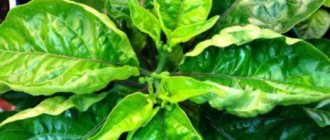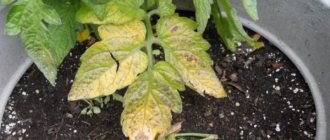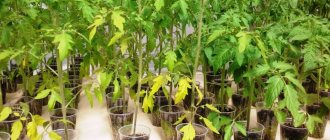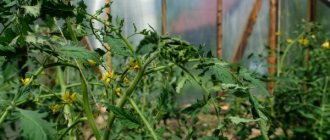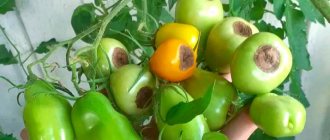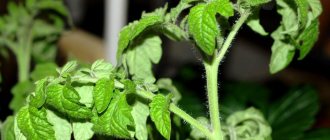From sowing tomato seeds to the end of harvest, six months or more pass. Of course, if the bushes do not have to be removed ahead of schedule due to diseases or pests. It is necessary to regularly inspect plants, identify problems in time, determine their causes and begin treatment. When the leaves of tomatoes curl, even experienced gardeners do not always know what to do and rush to treat the plants with fungicides or insecticides. Although often it is enough just to adjust the care a little.
Deviations from the thermal regime
Temperature fluctuations are the main reason why tomato leaves curl and dry in a greenhouse. Exorbitant temperatures in the greenhouse and hot, sultry weather when cultivating tomatoes in the garden are extremely unfavorable phenomena.
Important! The optimal temperature for greenhouse tomatoes is +22 degrees during the day and +18 degrees at night.
Temperatures above +30 degrees put plants under stress. To reduce the evaporation of precious moisture, tomato leaves are rolled into a tube. With the onset of twilight they spread out again.
To eliminate this reason for healthy tomato leaves curling in a greenhouse, you need to:
- open doors, transoms;
- whitewash the roof with chalk;
- curtain with a special fabric.
In extreme heat, garden tomato beds can be shaded and the tomatoes can be fed with nitroammophos at the rate of 20 g per 1 m², having previously dissolved the fertilizer in water.
You also need to water the tomatoes so that they do not curl with increased water in the morning or evening hours. The row spacing should be mulched with straw (sawdust).
If the heat in the greenhouse causes the leaves to curl inward, you can try spraying the plantings with a urea solution prepared according to the following recipe:
- urea – 2 tbsp. l.;
- water – 10 l;
- consumption of the prepared liquid – for 10 bushes.
After waiting a few days, it is recommended to re-treat the tomatoes against leaf curl with potassium sulfate, dissolving 10 g in 10 liters of water. This solution is enough for 10-11 bushes.
Features of the variety
Finally, leaves can curl for an objective reason - the physiological characteristics of the variety. Very often this phenomenon is observed in small-fruited cherry tomatoes. They are grown both in a greenhouse or in the ground, and on window sills. In this case, you don't need to do anything.
Thus, leaf curling may be due to one or several reasons. It is worth understanding that damaged foliage will not return to its lost shape. However, if everything is done correctly (watering, fertilizing and other measures), new leaves will appear normally. This is important for the health of the plant and a good harvest of tasty tomatoes.
Acute moisture deficiency
A common reason why the leaves of tomato seedlings curl up in a boat is a lack of moisture. It is recommended to water tomatoes abundantly and regularly, without long breaks.
A high need for moisture in tomatoes occurs after planting seedlings in garden beds or in a greenhouse. At this point, it is advisable to pour 4 liters of liquid onto each bush. After waiting 10 days, it is recommended to re-water, increasing the watering rate by 50%.
The following is based on the weather:
- if it’s hot and the tomatoes are slightly wilted, you need to water them twice a week;
- in cool weather, 1 irrigation per week is sufficient.
When the ovaries begin to form, the watering rate is increased by 1/3.
Experiencing a moisture deficit, the tomato begins to reduce the proportion of evaporated moisture and the leaves of the plant curl inward. Having noticed this, you should immediately start watering.
Photo. Tomatoes suffering from moisture deficiency
What to do to prevent the phenomenon?
The best remedy in the fight against plant diseases is prevention. Measures taken in advance can protect plants from disease and damage, and also guarantee a good harvest. After considering all the possible causes of leaf curling, you can briefly formulate the basic rules that should be followed in caring for tomatoes. Proper care is simply necessary for such fastidious plants.
Avoid overheating tomatoes
On hot summer days, tomatoes are most exposed to the scorching rays of the sun. Plants planted in open ground are more difficult to protect than those placed in a greenhouse. Shading the plant is the best solution to the problem. If the heat takes your garden by surprise, you can prevent the soil from drying out by more carefully controlling your watering.
Water correctly
It is recommended to water the plants no more than once a week, provided that the air temperature is stable. Tomatoes are heat-loving and do not require much water in normal weather.
It is necessary to water each bush at the root - such requirements are determined by the structure of the root system of tomatoes. The main root goes deep underground, so the taproot system requires such a distribution of moisture so that it reaches the root.
Avoid excess moisture at the roots
Excessive moisture also has a negative effect on the crop. Moisture promotes root rot and inhibits the development of the root system. Regular transfusion of water also disrupts the taste of tomatoes and prevents the absorption of beneficial substances from the soil.
Proper care
Any changes noticed in the early stages of development are much easier to prevent than to try to save a dying plant. Errors in care can usually be corrected quickly and easily.
Lack of soil nutrition elements
The next reason why the leaves of tomato seedlings wither and curl is a lack of certain nutrients. Due to a lack of certain elements, the upper or lower leaves of the plant curl up or down; let’s look at how to deal with this deviation.
Phosphorus deficiency
With a small amount of phosphorus, the leaves curl upward, and the underside of the leaf blade turns purple. This disease can be cured by applying superphosphate under tomato bushes. Do the following work:
- 150 g of superphosphate pour 1 liter of boiling water;
- leave the composition for 20 hours;
- Dilute the extract with 10 liters of water;
- Water the resulting solution at the rate of 500 ml under the tomato bush.
Important! You can limit yourself to adding dry ash under the bushes, then you will have to wait a week longer for the result.
Copper deficiency
Copper is important in growing tomatoes. Copper deficiency is less common than others, especially when bushes are treated with Bordeaux mixture against fungal diseases.
Symptoms of copper deficiency:
- the edges of the leaves curl up;
- random blurry yellow spots appear on the leaf blade;
- then the tomato leaves turn black and die, as shown.
How to save the plant in this case? Experienced gardeners recommend spraying the bushes with any copper-containing preparation.
Important! Using this method, you can compensate for copper deficiency and protect tomato bushes from a number of diseases.
Little potassium in the soil
If the leaves curl up into a tube, a brown border appears along their edges - this is a symptom of a lack of potassium for nutrition. Treatment for such twisting is carried out by applying potassium fertilizer.
Potassium nitrate contains potassium and some nitrogen.
The solution is prepared and added as follows:
- dilute 1 tbsp. l. saltpeter in 10 liters of water;
- stir until completely dissolved;
- water, spending 500 ml for each bush.
Adherents of folk remedies for combating tomato diseases can treat with ash extract according to the following recipe:
- Pour boiling water over 100 g of ash;
- leave the composition for a day;
- every 2 hours the solution must be stirred;
- strain the solution;
- water the tomatoes at the root level at the rate of 500 ml per bush.
Important! You can spray tomato bushes with an ash solution; for better adhesion, it is advisable to add 30 g of soap to the composition.
Nitrogen deficiency
Nitrogen starvation occurs on depleted soils and when technology requirements are neglected. If there is insufficient nitrogen, the plant develops a yellow tint and the upper leaves become smaller.
When the leaves begin to lighten and curl downward, the tomatoes are experiencing severe nitrogen starvation. Then the leaves become yellow and dry out.
It is urgent to apply nitrogen fertilizer. Nitrogen starvation can be stopped by watering the bushes with herbal infusion.
Small proportion of calcium in the soil
The calcium type of starvation causes the leaf blade to curl upward, and the fruits are affected by blossom end rot.
How to feed tomatoes in such a situation? Vegetable growers use the following recipe:
- calcium nitrate – 21 g;
- ash – 380 g;
- urea – 11 g.
Important! All ingredients are diluted in a bucket of water, mixed and the solution is used for root feeding. One bucket is enough for 4 m² of plantings.
Why do tomato leaves curl down?
Sometimes even experienced gardeners encounter this phenomenon. This does not always indicate improper care. Inwardly curled leaf blades are considered normal for some tomato varieties (Honey Drop, Fatima, Oxhart and parts of cherry tomatoes). This feature is typical for young tomato seedlings. The cotyledon leaves curl down, but the shoots themselves remain strong and healthy. If this is not the case, it means that the plants are influenced by some external factors.
Mistakes when watering
If the soil is not sufficiently moistened, the leaves on the bushes begin to curl. This is a consequence of irregular watering or a violation of the technology itself. In open ground, tomatoes are watered every 2-3 days. If the soil is mulched, then less often - every 5 days.
The frequency will depend on the weather and the plants themselves. Bushes with ovaries require more moisture. During this period, tomatoes are in the active growth phase, and one bush requires a bucket of water. This amount is divided into several parts and watered gradually so that the moisture has time to be absorbed into the soil. Otherwise, it will simply spread to the sides without affecting the roots.
Water tomatoes in the garden only early in the morning or in the evening after sunset. During the daytime, burns will remain on the leaves.
Excess moisture is also unacceptable. It leads to deformation of the sheet plates, only they curl upwards rather than downwards. Don't be overzealous with watering. If the soil is wet enough, it is better to let it dry for about 7-10 days. In rainy weather, special furrows are made near the grooves to drain excess moisture. The soil needs to be loosened regularly. Stagnation of water leads to the development of root rot. As a result, the seedlings disappear.
Heat
Tomatoes are heat-loving plants, but excessive heat is detrimental to them. To cool the greenhouse a little, they resort to ventilation, but without drafts. In open ground, bushes need to be shaded and watered more often. The areas of soil between them are covered with agrofibre or covered with hay. To maintain plants, they resort to foliar feeding: the leaves are sprayed with solutions of potassium sulfate or urea.
In spring, seedlings need to be protected from the sharp contrast of day and night temperatures. It is better to close the greenhouse at night, and open it for free air circulation during the day.
Incorrect feeding
Fertilizers are important for the normal growth and development of seedlings. But their uncontrolled application harms plants. At home, an overabundance is especially dangerous. Depending on what exactly was added in greater quantities than required, not only the leaves curl, but other alarming signs also appear.
Here's how an excess of certain elements affects tomatoes:
- Manganese. The leaf blades begin to curl and become wrinkled, then turn bright green.
- Zinc. The edges of the leaves curl, and the stems and lower leaves acquire a purple tint.
- Nitrogen. The leaves begin to curl only at the top. Wood ash will help eliminate the effects of high nitrogen concentrations. Under each bush you need to loosen the soil and add about 70 g of ash. You can also use potassium sulfate at a rate of 10 g/m2.
In order not to harm the tomatoes, it is better to use ready-made complex fertilizers. Their composition is already balanced, you just need to follow the recommendations on the packaging.
Macronutrient and micronutrient deficiencies
A lack of essential minerals leads to deformation of the leaf plates. First, their color changes, then they begin to curl, dry out, turn yellow, wither or crumble. The process happens in different ways.
It all depends on what specific element is missing:
- Phosphorus. The leaf blades turn gray and fold into a tube. A superphosphate solution will help the tomato recover.
- Copper. The leaves curl and turn yellow. If you do not help the plant, they will gradually turn black. The bushes need to be treated with copper-containing preparations.
- Bora. Not all the leaves curl, but only in the middle of the bush. They also become covered with red veins and then turn completely yellow.
- Potassium. The leaf plates are bent from the edges to the middle. Wood ash or potassium nitrate can help.
- Gland. The leaves lose their elasticity, sag and turn yellow, and the tips bend. Complex fertilizer will help return them to normal.
Damage to roots during diving
The sprouts are very tender, but the roots are still weak. Any careless movement can easily damage them. Immediately after transplantation, the leaves sometimes curl. The root system itself regenerates. This will take some time (about a week). As soon as the roots are restored, the leaves will also return to their original state.
Bad soil
The best option is light and loose soil, through which moisture and oxygen can easily pass to the roots.
Heavy soil is considered absolutely unsuitable:
- It does not allow air to pass through and does not absorb moisture well:
- It stagnates, as a result of which the roots quickly begin to rot, the leaves also suffer from this, and a kind of curliness appears.
You should also not transplant tomatoes into cold soil. It should be moderately fertilized and have low acidity.
Tight capacity
The seedlings grow and develop, and the root system strengthens along with the tops. If the pot becomes too crowded, the plants will not receive enough nutrients. Their growth slows down, and the only way to save the bushes is to move them into open ground or transplant them into larger containers.
Late stepsoning
If you don’t get rid of dried out shoots in time, the balance between the root system and tops is disrupted. The same thing will happen if you trim too many leaves at once (maximum 2 to 3 leaves per week). Pinching is carried out when the sprouts reach a length of 5 to 7 cm.
The air is too humid
In greenhouse conditions, tomatoes thrive at air humidity of less than 60%. But as soon as the indicator becomes more than 70%, rot spots appear on the leaf blades. For prevention purposes, you need to regularly ventilate the greenhouse.
Excessive nutrient content
Some summer residents, in pursuit of high yields, apply a lot of mineral fertilizers. As a result, the leaves dry out and turn yellow, not because the plants lack something, but because of the application of excess fertilizers. Let's see what happens to tomatoes that are overfed with nutrients.
Excess nitrogen
If the soil contains an excess amount of nitrogen, the tops of the tomatoes curl, but the remaining leaves look quite normal.
Elimination of the problem: to correct the situation, immediately stop nitrogen fertilizing. To neutralize the effects of nitrogen, add potassium sulfate or ash extract to the soil.
Excessive amount of zinc
With excess zinc content, tomato leaves curl upward, and it may seem that the bushes do not have enough moisture. However, on the lower tier of the tomato bush, a secondary symptom of zinc overfeeding occurs - a purple color on the leaves and stems.
Elimination of the problem: you need to stop fertilizing and add organic matter.
Lots of manganese in the soil
If there is too much manganese in the soil, the leaves first curl, then become corrugated and turn bright green.
Elimination of the problem: you should stop feeding tomatoes with microelements.
Twisting due to illness
Various diseases can cause curling and deformation of tomato leaves.
Bacteriosis can be recognized by the fact that most of the leaves on the tomatoes are curled up. The shoots are small and weak, the inflorescences are inconspicuous and small. The carrier of this disease is aphids.
In general, bacteriosis is incurable, but if it affects an adult plant, then there is a small chance of saving the harvest. To do this you need to pinch the tops. But this method does not always help. If bacteriosis has infected a young plant, then it should be dug up and burned, and the soil should be disinfected.
Bacterial cancer is an incurable disease. There are several signs of this disease:
- brown cankers on shoots;
- the leaves curl into a tube and dry quickly;
- stems crack;
- brown marks on the cut of the lower leaves.
IMPORTANT! Bacterial cancer is transmitted through plant debris, so affected tomatoes are burned away from the garden.
Bacterial cancer of tomato
It is impossible to cure bacterial cancer. But there is a way to warn him. Fitolavin solution for 2 hours before transplanting .
Fitosporin for preventive purposes .
Fusarium most often appears on the lower leaves. They are the first to curl, after which the disease quickly spreads to the remaining leaves and shoots. Very soon they begin to die. This disease also affects fruits, making them unfit for consumption.
A solution of copper oxychloride, Bordeaux mixture, helps in the fight against this disease.
Mechanical root injuries
After placing young seedlings in a permanent place, their leaves curl a little; this should not frighten the vegetable grower. In a week the bushes will look quite normal. If recovery does not occur, then the bushes should be treated with stimulating drugs.
Sometimes vegetable growers injure the roots when weeding and loosening tomatoes. As a result, the leaf plates curl upward along the entire length of the bush. To support the plants, you need to water the tomatoes so that they do not curl with a stimulating drug:
- Kornevin;
- Epin Extra;
- Cornerost;
- Zircon.
Fever
Incorrect temperature conditions have a very bad effect on tomatoes. In this case, not only the leaves curl, but also the color and ovary are shed.
If tomatoes grow in greenhouse conditions, then the situation can be corrected with the help of ventilation. If the structure does not have windows, then whitewashing the walls or covering them with gauze will help.
When tomatoes are growing in the area, try the following:
- try to shade the bed;
- increase morning and evening watering;
- add nitroamosphosphate diluted with water to the soil, about 20 g of the substance per 1 sq. m.
Afterwards, cover the soil between the rows with hay or agricultural material. For best effect, mulch the ground.
Attention! If you notice that the problem has become widespread, then you need to feed the plants with urea. Take 1.5 tbsp per bucket of water. l. urea and add 1 liter under each bush. solution. After three days, feed the tomatoes with potassium sulfate.
Violation of pinching technology
The leaves at the top of the bush and in its central part curl due to improper execution of the pinching procedure. Stepchildren grow from each leaf axil; they should be removed by breaking them off at a length of 5 cm. When the formation of bushes is delayed and the stepsons are broken out late, leaf curling begins.
Important! If overgrown stepsons have been removed and the tomato leaves have curled, you should spray the bushes with Zircon.
Pest exposure
Pests also cause damaged leaves of tomatoes to curl in greenhouses and open ground. Below are the most harmful insects that damage leaves.
Whitefly
This small white butterfly is a serious pest of greenhouse tomatoes. The butterfly and its larvae drink tomato juice, secreting sweet honeydew. This sticky mass is colonized by sooty fungus. As a result, the leaves curl into a tube and the tomatoes turn black, which leads to a significant loss of yield.
In case of focal spread of the pest, Fitoverm is used. If the spread of butterflies has become widespread, carry out 3 treatments at weekly intervals with Aktara.
Aphid
It is mainly garden tomatoes that suffer from the effects of aphids. The insect sucks the sap, causing the upper leaves to curl.
To destroy aphids, the following means are used:
- Spark;
- Proteus;
- Aktara.
Spider mite
This pest is classified as sucking. As a result of the influence of the mite, the leaves of tomatoes in the greenhouse begin to curl and dry out.
You can control the number of ticks using acaricidal agents:
- Flumaita;
- Borneo;
- Oberon.
Diseases
Various bacteria, fungi, and viruses can provoke leaf curling. Tomatoes are prone to developing dangerous diseases (bacterial canker, Fusarium wilt or Verticillium wilt), the main symptom of which is downward curling. the upper leaves are mainly infected . After the leaves curl, they begin to wither, turn brown and dry out. Cracks and ulcerations form on the stems.
How to treat diseased tomatoes? If tomatoes are affected by cancer, it is useless to treat them; they also pose a threat to healthy plants. Therefore, they must be removed from the greenhouse and destroyed. For other diseases, copper oxychloride (1 liter) diluted in water (10 liters) will help.
Diseases of culture
Diseases are also the cause of leaves curling in tomatoes growing in greenhouses and open ground.
| Name of the disease | Symptoms | Control measures |
| Stolbur |
| The effect is achieved by treatment with Phytoplasmin. |
| Bacterial cancer |
|
|
Important! When treating for cancer, try to completely wet all the leaves with the chemical. It is advisable to wet the soil surface as well.
What to do if the leaves on tomatoes curl up, wither, turn yellow: tips
Above, complete information was given about the causes of leaf curling and how to deal with this problem. If you noticed in time and immediately rushed to destroy your harvest, then you can quickly correct the situation. We want to give you some recommendations to avoid this phenomenon and what to do about it.
- The main thing is to carry out prevention. It is easier to prevent any disease than to treat it. Garlic tincture and potassium permanganate solution are perfect for prevention. They fight pests and diseases, and also provide the tomatoes with the necessary substances. And, of course, they increase immunity.
- Onion peels or fresh onions also cope well with diseases.
- Remove tomato tops and remove weeds as needed. Do not put them even next to the harvest, but take them directly to the designated place.
- If one or two bushes are sick, then without regret you will tear them out and burn them. Otherwise, the disease will spread to other bushes, and then the entire harvest may be lost.
- Don't water your tomatoes too often. If the summer is dry and hot, then you need to water them well at the very root. Otherwise, 1 liter per bush is enough.
It is important to take action in time
- Do not get carried away with chemicals, give preference to folk remedies. They don't work like that, but they're also less harmful.
- If, in the case of pests, traditional methods have not yielded any results, then use a chemical attack as your assistant. But after it, the harvest can be harvested only after 3 weeks.
- Destroy diseased plants immediately!
- If you are too carried away with fertilizers, and there is no way to change the soil. Water for several days with clean water, preferably warm and settled, and ideally rain.



